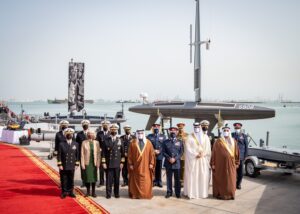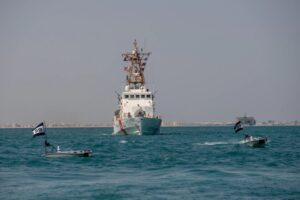The Chief of Naval Operations last week said the Navy’s 5th Fleet task force experimenting with unmanned systems in the Middle East aims to reach 100 networked unmanned platforms operating together within a year among the U.S. Navy and its partners.
“Our goal is to have 100 network unmanned platforms operating together, tied together in a mesh network that delivers an understanding of what’s afloat out there, whether it’s in the Red Sea and the Arabian Gulf, to get to 100 unmanned by next year, by the summer of 2023,” Adm. Mike Gilday said during a Heritage Foundation event on Aug. 25.

He noted that on any given day the U.S. Navy and its coalition partners have up to four or five ships operating in the Red Sea, which he compared to the size of California.
“Think about five patrol cars trying to secure the state of California. And then think about the power of unmanned and what that capability gives you in terms of sensing, and then understanding at the tactical edge in these operations centers, in our partner nations, leveraging [artificial intelligence],” Gilday continued.
Task Force 59, under 5th Fleet, was started nearly a year ago to help test and integrate unmanned systems and artificial intelligence into the Navy (Defense Daily, Sept. 9, 2021).
Its experimentation includes off-the-shelf technology that focuses on Unmanned Surface Vessels (USVs) like the 23-foot wind-powered Saildrone Explorer with an endurance of over 365 days, the MARTEC Mantas T12 12-foot long USV operating out of Bahrain, and MARTEC Devil Ray T-38 USV.
Earlier this year, 5th Fleet headquarters in Bahrain launched the biennial International Maritime Exercise (IMX) 2022, which included 80 unmanned systems, 50 manned ships, and 60 countries experimenting in the region. IMX 22 is the largest unmanned exercise in the world (Defense Daily, Feb. 2).
Gilday said when he first became CNO he considered unmanned systems similar to any shipbuilding or aircraft production line, with a seven to 15 year-long process to move from first design to testing and acceptance to delivery.
“We can’t do that with unmanned. With unmanned technologies that are out there, we’ve developed a DevOps kind of environment with Unmanned Task Force and the Pentagon that’s closely connected to Task Force 59, which operates out of Bahrain. And that task force is operating with six or seven different countries, as a team right now, to increase maritime domain awareness using unmanned in the air and on the sea.”

Gilday said with unmanned systems “we are making, I think, breathtaking progress right now.”
He also highlighted the importance of AI software plugs in unmanned systems over specific platforms going forward.
“In terms of unmanned itself, one of the biggest changes is the way that we’re looking at the magic sauce for AI…it isn’t necessarily the platform, it’s the AI software integration that plugs in.”
Gilday compared his vision of the Navy’s future to advances in cars. He said beyond the “digital native” Tesla [TSLA] other platforms participate like Volkswagen and Ford [F].
“The secret sauce is that AI software plug, and we don’t have to have the same company that develops both of these. It’s a very competitive environment, small companies are making the magic plug-in that we can change out very quickly.”
He also reiterated the Task Force 59 experimentation on unmanned and AI systems is informing progress in larger systems like the medium and large unmanned surface vessels, “that we would hope to scale later on in this decade.”